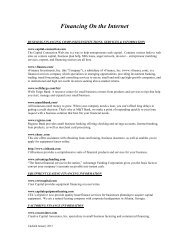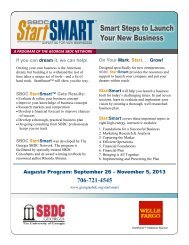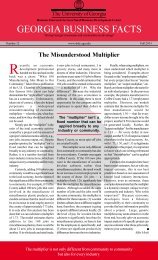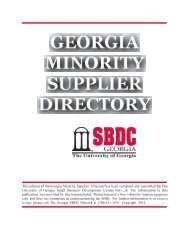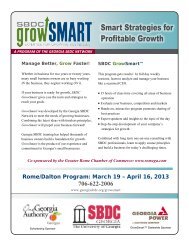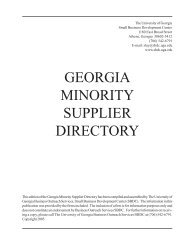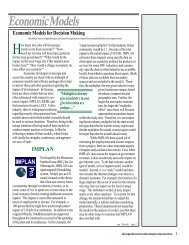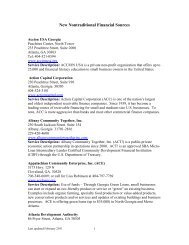Looking Ahead - Georgia Small Business Development Center
Looking Ahead - Georgia Small Business Development Center
Looking Ahead - Georgia Small Business Development Center
You also want an ePaper? Increase the reach of your titles
YUMPU automatically turns print PDFs into web optimized ePapers that Google loves.
sometimes at a competitive disadvantage in these. When these positions go unfilled, smallbusinesses are forced to seek other alternatives, such as having existing employees work morehours, leaving positions vacant, or turning down work. 26<strong>Business</strong>es, of course, have also explored hiring talented foreign workers, especially inmath, science, and engineering. The U.S. benefits from having a skilled workforce whether thoseemployees were native or foreign born. There is a lot of evidence that immigrants are extremelyentrepreneurial, with one study stating that 25 percent of the new engineering and technologycompanies were started by immigrants. 27 With this in mind, policymakers need to find ways toencourage the legal immigration of these high-skilled employees, which is currently very difficultto do for both small and large firms. 28Global CompetitionAs Thomas Friedman, notes, the world is growing “flatter” and Americans facecompetitors on a number of fronts, both at home and abroad. 29 Much has been written on thistopic, as the debate over globalization continues to garner attention in academic, media, andpolitical circles. The U.S. government has worked to increase the ability of Americans tocompete overseas by lowering trade barriers. 30 Government can also help ensure that trade lawsare enforced.Recently, the National Association of Manufacturers (NAM) released studies on thestructural costs of lowering manufacturing costs in the United States compared with its tradingpartners. They found that U.S. manufacturers pay 31.7 percent more in nonproduction costsrelative to the nation’s nine largest trading partners. Much of the difference is accounted for inhigher costs for tax and regulatory compliance, energy expenditures, health and retirementbenefits, and tort litigation. 31 U.S. businesses can effectively compete if they continue to meet theneeds of their customers, rely on cutting-edge technology and innovation, and keep theirbusinesses flexible and entrepreneurial (including exploring new markets through exporting). 32One way American companies have been able to reduce their costs is by outsourcingsome processes and tasks abroad. By producing some inputs elsewhere at a lower cost, firms canmore effectively compete on price while focusing domestic production efforts in other areas. To26 National Federation of Independent <strong>Business</strong> (2001).27 Wadwha et al. (2007).28 Schramm and Litan (2008).29 Friedman (2005).30 For more information on small business opportunities and exports, see Moutray and Tobias (Forthcoming, 2008).31 Leonard (2003, 2006).32 RSM McGladrey (2006).6



